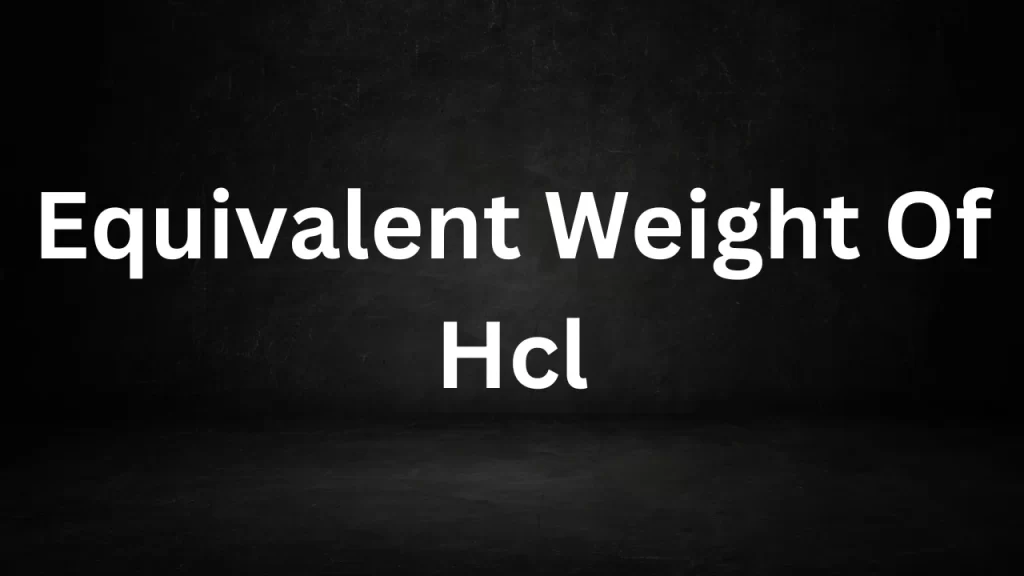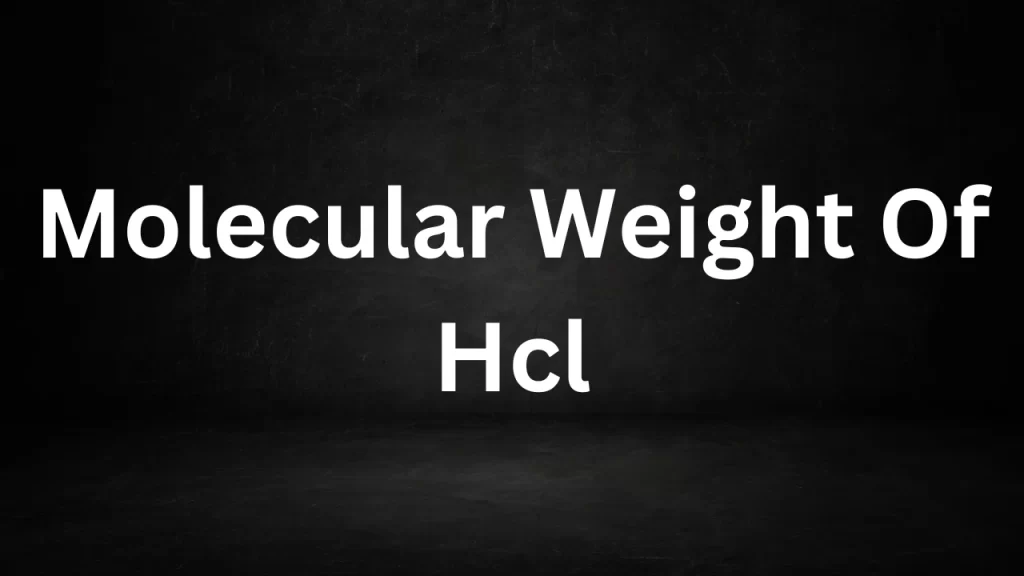Tag: histidine hcl monohydrate molecular weight
Equivalent Weight of HCL
Equivalent Weight Of Hcl: The equivalent weight of hydrochloric acid (HCl) can vary depending on its role in a chemical reaction. To determine the equivalent weight of HCl for a specific reaction, you need to consider whether it acts as a monoprotic or diprotic acid and the specific stoichiometry of the reaction.
 Equivalent Weight Of Hcl
Equivalent Weight Of Hcl
Here are two scenarios:
1. HCl as a Monoprotic Acid:
In this case, HCl donates one hydrogen ion (H⁺) in a chemical reaction. Its equivalent weight is calculated by dividing its molar mass by the number of moles of H⁺ ions it donates, which is 1.
Molecular Mass of HCl = Approximately 36.461 g/mol (as previously calculated) Equivalent Weight of Monoprotic HCl = Molecular Mass of HCl / 1 = 36.461 g/mol
So, the equivalent weight of monoprotic HCl is approximately 36.461 g/mol.
2. HCl as a Diprotic Acid:
In certain reactions, HCl can act as a diprotic acid, meaning it donates two hydrogen ions (H⁺). In this case, its equivalent weight is calculated by dividing its molar mass by the number of moles of H⁺ ions it donates, which is 2.
Molecular Mass of HCl = Approximately 36.461 g/mol (as previously calculated) Equivalent Weight of Diprotic HCl = Molecular Mass of HCl / 2 = 36.461 g/mol / 2 ≈ 18.231 g/mol
So, the equivalent weight of diprotic Hydrogen Chloride is approximately 18.231 g/mol.
It’s important to note that the equivalent weight of Hydrogen Chloride varies based on its role in the specific chemical reaction you are considering. Depending on whether it acts as a monoprotic or diprotic acid, you will use the corresponding equivalent weight in stoichiometric calculations for that reaction.
Read More
- Light Filtering Polaroid Films Polarization
- Animals Biology Science Lion Zoology
- Difference Between Voltage And Current
- Difference Between Two Stroke And Four Stroke
- Difference Between Ac And Dc
Frequently Asked Questions (FAQs) Equivalent Weight Of Hydrogen Chloride
1. What is the equivalent weight of hydrochloric acid (HCl)?
The equivalent weight of hydrochloric acid (HCl) can vary depending on its role in a chemical reaction. It is determined by considering whether Hydrogen Chloride acts as a monoprotic or diprotic acid in the reaction.
2. How is the equivalent weight of Hydrogen Chloride calculated when it acts as a monoprotic acid?
When Hydrogen Chloride acts as a monoprotic acid (donating one hydrogen ion, H⁺), its equivalent weight is calculated by dividing its molar mass by the number of moles of H⁺ ions it donates, which is 1. The molar mass of Hydrogen Chloride is approximately 36.461 g/mol. So the equivalent weight for monoprotic Hydrogen Chloride is approximately 36.461 g/mol.
3. How is the equivalent weight of Hydrogen Chloride calculated when it acts as a diprotic acid?
In cases where HCl acts as a diprotic acid (donating two hydrogen ions, H⁺), its equivalent weight is determined by dividing its molar mass by the number of moles of H⁺ ions it donates, which is 2. The equivalent weight for diprotic Hydrogen Chloride is approximately 18.231 g/mol.
4. What is the significance of knowing the equivalent weight of Hydrogen Chloride in chemistry?
Knowing the equivalent weight of Hydrogen Chloride is essential for stoichiometric calculations in chemical reactions. It helps determine the amount of Hydrogen Chloride required for a specific reaction. The concentration of Hydrogen Chloride solutions, and the prediction of reaction outcomes.
5. Can the equivalent weight of Hydrogen Chloride change in different chemical reactions?
Yes, the equivalent weight of Hydrogen Chloride can vary in different chemical reactions based on its role as a monoprotic or diprotic acid and the stoichiometry of the reaction. It is specific to the reaction being considered.
Molecular Weight Of Hcl
Molecular Weight Of Hcl: The molecular weights of hydrochloric acid (HCl) can be calculated by adding the atomic masses of its constituent elements:

Molecular Weight Of Hcl
Calculating the Molecular Weight of HCl:
Hydrochloric acid (HCl) consists of two elements: hydrogen (H) and chlorine (Cl). To calculate its molecular weights, we add the atomic masses of these elements:
- Hydrogen (H) has an atomic mass of approximately 1.01 g/mol.
- Chlorine (Cl) has an atomic mass of approximately 35.45 g/mol.
Now, let’s compute the molecular weight of HCl:
Molecular Weights of HCl = Atomic Mass of Hydrogen + Atomic Mass of Chlorine
Molecular Weights of HCl = 1.01 g/mol + 35.45 g/mol
Molecular Weights of HCl ≈ 36.46 g/mol
So, the molecular weights of hydrochloric acid (HCl) is approximately 36.46 grams per mole.
Significance of HCl’s Molecular Weight:
Understanding the molecular weights of HCl is crucial for several reasons:
- Stoichiometry: Molecular weights plays a vital role in chemical calculations, such as stoichiometry, where it helps determine the quantity of reactants and products in chemical reactions involving HCl.
- Concentration: In analytical chemistry and laboratory work, the molecular weights of HCl is used to calculate the concentration of solutions accurately. This is essential for preparing solutions of known strength.
- Industrial Applications: In various industrial processes, HCl is used for tasks like cleaning, pickling metals, and manufacturing chemicals. Knowledge of its molecular weight is necessary for quality control and production procedures.
- Environmental Monitoring: HCl is a common pollutant in industrial emissions. Monitoring and regulating its presence in the environment require precise measurements, often based on its molecular weight.
- Safety: Handling HCl, a highly corrosive acid, necessitates a comprehensive understanding of its properties, including molecular weight, to ensure safe storage and usage.
Conclusion:
The molecular weights of hydrochloric acid (HCl), approximately 36.46 g/mol, is a critical parameter in the world of chemistry. It facilitates accurate measurements, precise calculations, and the efficient use of HCl in various scientific, industrial, and environmental applications. By understanding its molecular weights, scientists and engineers can harness the potential of HCl while ensuring its safe and responsible use.
Read More
- Molecular Weight Of Nitrogen
- Molecular Weight Of NaOH
- Difference Between Force And Pressure
- Difference Between Diode And Rectifier
- Difference Between AM And FM
Frequently Asked Question (FAQs) Molecular Weight Of Hcl
What is the molecular weight of hydrochloric acid (HCl)?
The molecular weights of hydrochloric acid (HCl) is approximately 36.46 grams per mole (g/mol).
Why is knowing the molecular weight of HCl important in chemistry?
Knowing the molecular weights of HCl is crucial for various chemical calculations and laboratory procedures. It helps determine the amount of HCl in chemical reactions, the concentration of HCl solutions, and plays a role in quality control and safety considerations.
How is the molecular weight of HCl calculated?
The molecular weights of HCl is calculated by adding the atomic masses of its constituent elements: hydrogen (H) and chlorine (Cl). The atomic mass of hydrogen is approximately 1.01 g/mol, and the atomic mass of chlorine is approximately 35.45 g/mol.
Can you explain how molecular weight is used in stoichiometry with respect to HCl?
In stoichiometry, molecular weights is used to determine the molar ratios of reactants and products in a chemical reaction. By knowing the molecular weights of HCl, you can calculate how many moles of HCl are involved in a reaction and relate it to other reactants and products.
Are there practical applications of HCl’s molecular weight in industry?
Yes, HCl is used in various industrial processes, such as metal pickling, chemical manufacturing, and water treatment. Its molecular weights is crucial for accurately measuring and controlling the amount of HCl used in these applications.